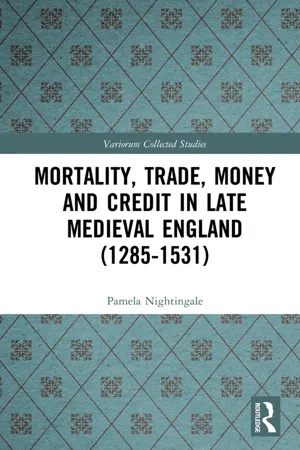
Mortality, Trade, Money and Credit in Late Medieval England (1285-1531)
- 288 pages
- English
- ePUB (mobile friendly)
- Available on iOS & Android
Mortality, Trade, Money and Credit in Late Medieval England (1285-1531)
About This Book
The eleven articles in this volume examine controversial subjects of central importance to medieval economic historians. Topics include the relative roles played by money and credit in financing the economy, whether credit could compensate for shortages of coin, and whether it could counteract the devastating mortality of the Black Death. Drawing on a detailed analysis of the Statute Merchant and Staple records, the articles chart the chronological and geographical changes in the economy from the late-thirteenth to the early-sixteenth centuries. This period started with the triumph of English merchants over alien exporters in the early 1300s, and concluded in the early 1500s with cloth exports overtaking wool in value. The articles assess how these changes came about, as well as the degree to which both political and economic forces altered the pattern of regional wealth and enterprise in ways which saw the northern towns decline, and London rise to be the undisputed financial as well as the political capital of England.
Frequently asked questions
Information
Table of contents
- Cover
- Half Title
- Series Page
- Title Page
- Copyright Page
- CONTENTS
- List of illustrations
- List of abbreviations
- Preface
- Acknowledgements
- 1 Some new evidence of crises and trends of mortality in late medieval England
- 2 Alien finance and the development of the medieval English economy, 1285–1511
- 3 The impact of crises on credit in the late medieval English economy
- 4 English medieval weight standards revisited
- 5 Finance on the frontier: money and credit in Northumberland, Westmorland and Cumberland, in the later middle ages
- 6 The intervention of the crown and the effectiveness of the sheriff in the execution of judicial writs, c. 1355–1530
- 7 The rise and decline of medieval York: a reassessment
- 8 The rise of London as a financial capital in late medieval England
- 9 Gold, credit, and mortality: distinguishing deflationary pressures on the late medieval English economy
- 10 Credit and the effect of the Black Death on regional commercial economies, 1350–1369
- 11 A crisis of credit in the fifteenth century, or of historical interpretation?
- Bibliography
- Index